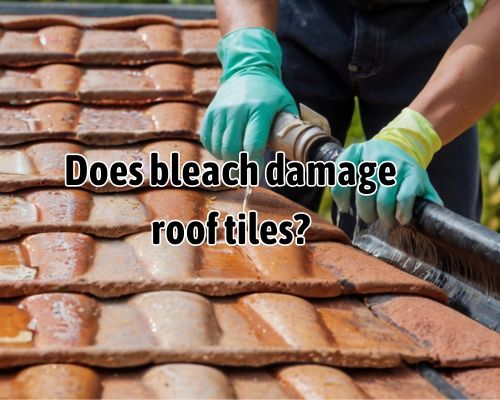
Does Bleach Damage Roof Tiles? The Truth for Homeowners in Melbourne, Australia
Maintaining a clean roof is essential for preserving the curb appeal and longevity of your home. In Melbourne, Australia, homeowners often struggle with the persistent growth of moss, algae, and lichen due to the city’s temperate oceanic climate. A common solution people turn to is bleach-based roof cleaning, but is this method truly safe? More importantly, does bleach damage roof tiles over time?

In this comprehensive guide, together with Gutter Cleaning Melbourne, we’ll explore the effects of bleach on different types of roof tiles, discuss safer alternatives, and offer best practices for roof maintenance in Melbourne.
Understanding Bleach and Its Effects on Roof Tiles
Bleach, particularly sodium hypochlorite, is a strong chemical commonly used for disinfecting and removing organic stains. While effective against mold, mildew, and algae, bleach can also have unintended consequences when used on roof tiles.
1. Chemical Erosion of Roof Tiles
Bleach is a highly corrosive substance, and prolonged exposure can degrade various roofing materials:
- Concrete tiles: Frequent bleach application can weaken the tile surface, causing it to become porous and brittle over time.
- Terracotta tiles: These tiles are particularly vulnerable since bleach can strip away their natural coating, leading to premature erosion.
- Slate tiles: While more resistant, repeated bleaching can gradually wear down their protective layer, making them more susceptible to water penetration.
2. Roof Sealant & Protective Coatings at Risk
Modern roof tiles often come with protective sealants that enhance their lifespan. Applying bleach directly can strip these coatings, making the tiles more prone to UV damage, cracking, and moisture absorption—all of which are particularly concerning in Melbourne’s climate, where heavy rainfall and fluctuating temperatures can exacerbate wear and tear.
3. Environmental and Health Concerns
Using bleach for roof cleaning poses risks beyond just your tiles:
- Runoff into stormwater drains can introduce toxic chemicals into Melbourne’s waterways, affecting local ecosystems and wildlife.
- Harmful fumes may pose respiratory risks to homeowners and nearby residents.
- Bleach overspray can damage plants, lawns, and even outdoor furniture.
Safer Alternatives for Roof Cleaning in Melbourne
Given the potential risks, many professional roofing specialists in Melbourne advise against using bleach and instead recommend gentler, eco-friendly alternatives.
1. Soft Wash Roof Cleaning
Unlike high-pressure washing, soft wash cleaning uses biodegradable cleaning solutions that eliminate algae and moss without causing damage to roof tiles. This method is preferred by many Melbourne roofing companies as it extends the lifespan of tiles while maintaining their structural integrity.
2. Oxygen Bleach (Sodium Percarbonate)
A safer alternative to chlorine bleach, oxygen bleach effectively removes stains without corroding tiles or harming surrounding vegetation. This method is particularly useful for delicate materials like terracotta and slate tiles, which are commonly found on Melbourne’s heritage homes.
3. Professional Roof Treatment Solutions
Many Melbourne roofing contractors offer specialized treatments using roof-friendly algaecides and fungicides. These solutions not only clean tiles but also prevent regrowth for extended periods, reducing the need for frequent maintenance.
Best Practices for Roof Maintenance in Melbourne
Melbourne homeowners should adopt a preventative approach to roof maintenance to avoid the need for harsh chemical cleaning. Here are some expert recommendations:
1. Regular Inspections
Conducting bi-annual roof inspections can help identify moss, algae, and debris buildup early on. Many local roofing companies in Melbourne offer free roof inspections, making it easy for homeowners to stay proactive.
2. Gutter Maintenance
Clogged gutters contribute to excess moisture on the roof, creating an ideal environment for algae growth. Keeping your gutters clean ensures proper drainage and prevents water from pooling around tiles.
3. Installing Zinc or Copper Strips
Metal strips installed along the ridge of the roof gradually release metallic ions that inhibit moss and lichen growth. This technique is widely used in Melbourne due to its long-term effectiveness and low maintenance requirements.
4. Hiring Local Roof Cleaning Professionals
For optimal results, consider hiring a Melbourne-based roof cleaning specialist like Gutter Cleaning Melbourne who understands the region’s specific weather challenges and can recommend tailored maintenance plans for your roof type.
Final Verdict: Should You Use Bleach on Roof Tiles?
While bleach is an effective short-term solution for removing stains and organic growth, its long-term effects on roof tiles can be detrimental—especially for concrete, terracotta, and slate roofs commonly found in Melbourne. The risk of tile degradation, environmental harm, and safety hazards makes it an unsuitable choice for routine roof maintenance.
Instead, gentler, eco-friendly alternatives such as soft wash cleaning and oxygen bleach offer a safer and more sustainable approach to keeping your roof in top condition.
If you’re concerned about your roof’s health and need expert advice, consulting a Melbourne-based roofing specialist can help you determine the best cleaning method for your specific tile material and environmental conditions.
Need Professional Roof Cleaning in Melbourne?
For professional, bleach-free roof cleaning solutions in Melbourne, reach out to licensed roofing contractors who specialize in tile preservation and eco-friendly cleaning methods. Regular maintenance not only protects your investment but also ensures your home remains beautiful and structurally sound for years to come.





